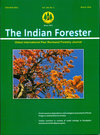Effect of Temperature and Relative Humidity on the Incubation Period and the Hatching Percentage of Eggs of Pammene theristis Meyrick (Lepidoptera: Tortricidae)
DOI:
https://doi.org/10.36808/if/2018/v144i3/122804Keywords:
Pammene theristis, Shorea robusta, Temperature, Relative Humidity, Incubation Period, Hatching Percentage of Eggs.Abstract
Pammene theristis Meyrick (Lepidoptera: Tortrlcldae) is a seed and seedling borer of Shorea robusta. The insect has been closely associated with the dying off of new Sal generation and plays a prominent role in regeneration failure in Sal. Surveys were conducted during IVIarch to October 2016 in various localities in and around Dehradun to find the effect of temperature and relative humidity on the oviposition of the borer. The results revealed that number of eggs laid were directly affected by temperature and evening relative humidity and indirectly affected by morning relative humidity. The incubation period was positively correlated with relative humidity in morning only and it is observed to be negatively correlated with maximum and minimum temperature and evening relative humidity. The percentage of hatching of eggs was positively affected by temperature and negatively affected by relative humidity.References
Beeson C.F.C. (1941). Ecology and control of forest insects in India and the neighbouring countries. Vasant press, Dehradun. Reprinted Govt, of India Publication. 1007 pp.
Buse A., Dury S.J., Woodburn R.J.W., Perrins C.M. and Good J.E.G. (1999). Effects of elevated temperature on multi-species interactions: the case of Pedunculate Oak, Winter Moth and Tits. Functional ecology, 13 (si): pp 74-82.
Champion H.G.andSethS.K. (1968). A Revised Survey of the Forest Types of India. The Manager of Publications, Delhi.
Chatterjee P.N. and Thapa R.S. (1970). Sal Regeneration: The Problem of Sal Seed and Seedling Borer Pammene theristis Meyricl< in
Dehradun Sal Forests (Lepidoptera: Eucosmidae). Indian Forester, 96 (8): 580-586.
Chitale V.S. and Behera M.D. (2012). Can the distribution of Sal (Shorea robusta Gaertn. f ) shift in the northeastern direction in India due to changing climate. Corrent Science, 102 (8): 1126-1135.
Choubey V., Kulkarni N. and Bhandari R. (2004). Incidence of Seed Insect Pests of Sal (Shorea robusta Gaertn. P.). Indian J. Tropical Biodiversity. 12:48-52.
Gauta m K. H. (1990).Regeneration Status of Sal (Shorea robusta) Forests in Nepal. Department of Forest Nepal, Kathmandu, 11 pp.
Gautam K.H. and Devoe N.N. (2006). Ecological and anthropogenic niches of Sal, (Shorea robusta. Gaertn. f) forest and prospects for multiple-product forest management; a review. Forestry, 79 (1): 81-101.
Ghorpade B.R. and Patil S. P (1991). Insect pests recorded on forest trees in the Konkan region of Maharashtra State (India). Indian Journal of forestry. 14 (3): 245-246.
Mathur R.N. and Singh B. (1960). A list of insect pests of forest plants in India and adjacent countries. Part-9- List of insect pests of plant genera S {SabiatoSyzigium). Ind. For. Bull., 171 (8).
Tewari D.N. [1995). A Monograph on Sal (Shorea robusta Gaertn. f). International Book Distributors, Dehradun, India.
Downloads
Downloads
Published
How to Cite
Issue
Section
License
Unless otherwise stated, copyright or similar rights in all materials presented on the site, including graphical images, are owned by Indian Forester.





